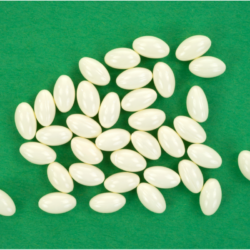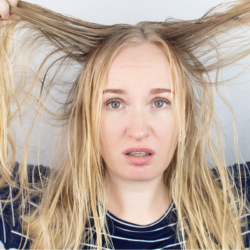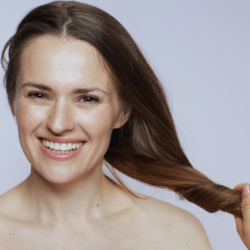Hair loss is a worry for women and men alike. A brush full of hair can be frightening, but it doesn’t always have to be.
Hair lasts between 3 and 7 years. Hair is constantly being renewed: it grows, lives, dies and eventually falls out. Hair is considered dead when it stops growing, i.e. when it no longer produces keratin. But that doesn’t mean it falls out immediately: it will take another 3 months before it detaches from the scalp, pushed by the arrival of a new hair.
What are the key points for hair growth?
Hair has the highest replication capacity in the body. Hair growth varies between 0.5 and 2 cm per month. This rate depends on a number of factors: genetics, sex, age and hormonal disorders. Growth is optimal between adolescence and the age of 30, then slows down towards the age of 40-50. The hair cycle is made up of three phases: growth (anagen), transition (catagen) and rest (telogen). At the end of the telogen phase, hair loss occurs, which is completely normal.
Our hair is constantly undergoing various stresses: hormonal variations, lifestyle, environment, diet or psycho-emotional state. These stresses can weaken the hair and trigger premature, sometimes pathological, hair loss (as in androgenetic alopecia). The hair cycle follows a precise order:
- Anagen: growth phase (2 to 6 years)
- Catagen: transitional phase (3 weeks)
- Telogen: resting phase (2 to 3 months)
At the end of the resting phase, the hair falls out. Every day, around 50 to 100 hairs reach this phase. The cycle starts again with the emergence of a new hair in the follicle.
Growth cycle disorders include :
- Anagen effluvium: an interruption in the growth phase resulting in abnormal anagen hair loss
- Telogen effluvium: significantly more than 100 hairs/day entering the resting phase
What causes hair loss?
The causes can be many and varied. Hair is an excellent indicator of deficiencies, particularly mineral deficiencies.
Mineral deficiencies have a direct impact on hair health
Hair is a true indicator of nutritional deficiencies, particularly in essential minerals. An iron deficiency can weaken the capillary fibre, making hair thinner and more brittle, and encouraging widespread and continuous hair loss, as this mineral is essential for oxygenation of the cells responsible for hair growth. Vitamin D, well-known for its role in calcium absorption, is also directly involved in the hair cycle, and its deficiency is strongly correlated with hair loss. Zinc, a powerful antioxidant, supports hair growth, and a lack of it can lead to hair loss and a dry scalp.
Magnesium regulates the pH of the scalp by neutralising the acidic effects of sweat; a deficiency can therefore cause irritation, dandruff and even seborrhoeic dermatitis, leading to significant hair loss. Calcium is closely linked to vitamin D, and its uptake is reduced if either is deficient, thus indirectly impacting hair health. Finally, group B vitamins, which are essential for hair shine and suppleness, play a major role in hair growth and resistance: if they are deficient, hair becomes dry, brittle and falls out more easily, with the possible appearance of dandruff.
Smoking, colouring and repeated exposure to the sun aggravate alopecia
Tobacco is responsible for many health problems and contains toxic and carcinogenic products. For both men and women, smoking can have disastrous consequences for hair. Scientific studies have shown that smoking can cause baldness. For healthier hair, stopping smoking is a difficult but important decision.
Regular hair colouring can, in some cases, lead to baldness. As the risk of damaging the scalp is not negligible, this can lead to a loss of density and dull, spiky hair.
In very small doses, the sun is excellent for all hair types. Through the intermediary of vitamin D, it acts on the life cycle of the hair and allows keratin to develop faster and more vigorously. But if the dose is too high, the consequences can be harmful. Excessive exposure to the sun accelerates the negative action of free radicals on the tissues surrounding the hair follicles. In the same way that rust attacks iron, these free radicals attack perifollicular collagen, causing it to lose its suppleness and potentially trapping the hair roots in a straitjacket. Another reason, which can add to the compression of the roots and the reduction in their activity!
If your hair already has a tendency to thin or fall out easily, beware of the sun and remember that autumn hair loss can be increased fivefold by summer’s carelessness.
Poor diet responsible for hair loss
An unbalanced diet or eating disorders can lead to an inadequate intake of nutrients, and ultimately to hair loss. Make sure you eat a healthy, balanced diet. Strong, healthy hair needs nutrients, which are essential for ensuring the correct physiological cycle of all tissues, especially if there is a high level of proliferation, such as the hair bulb. A constant supply of these nutrients must therefore be guaranteed by the blood.
The change of season affects alopecia
Like trees, our hair is sensitive to environmental changes: the transition to autumn is a period of radical change in the climate and therefore in hygrometry, sunshine, outside temperature… This change influences the rhythm and speed of the hair renewal cycle, which can then fall out in greater numbers.
The result is hair loss that affects the entire head of hair but has little impact on overall hair volume. This hair loss lasts a maximum of one to two months. After that, you should seek medical advice to determine whether there is any other cause of hair loss.
Hairstyles that are too tight encourage hair loss
Certain hairstyles, such as braids that are too tight, can encourage hair loss in women because of prolonged excessive traction on the roots. This is known as traction alopecia. Wearing a bun or ponytail every day can lead to long-term hair loss. That’s why prima ballerinas who are used to magnificent dance buns often suffer from this ailment. To remedy this, make sure you vary your hairstyles, never wear them too tightly and regularly loosen your hair.
Hormonal changes and loss of hair mass
Hair loss after childbirth is completely normal. It is due in particular to hormonal upheaval and the drop in oestrogen concentration. But this hair loss is only temporary and lasts only a few months. Hair loss can also be associated with the contraceptive pill, when you start taking it, stop taking it or change it.
Andropause is a biological phenomenon similar to the menopause in women, but which affects men. It is characterised by a gradual decrease in the production of male hormones, mainly testosterone. This hormonal decline can lead to a number of symptoms, including more pronounced hair loss. In fact, there is a direct link between hair loss and testosterone levels. Testosterone converts to dihydrotestosterone (DHT), a hormone which, when present in excessive quantities, can cause hair follicles to shrink, leading to hair loss. Thus, andropause can indirectly exacerbate baldness in men by causing a hormonal imbalance.
Some naturopathic advice to limit hair loss
- Avoid aggressive treatments: stripping shampoos, colouring, straightening and perming.
- Eat a balanced diet. Vary your meals to avoid deficiencies, especially in iron, zinc and sulphur-rich proteins.
- Reduce or stop smoking: it slows the absorption of key nutrients.
- Massage your scalp to stimulate blood circulation.
- Avoid blow-drying at too high a temperature.
- Manage stress. It throws hair cycles out of balance.
- Take your hormonal balance into account. Certain medicinal plants can help.
Medicinal plants and hair loss
Several natural active ingredients are recognised for their effectiveness in combating hair loss and strengthening the hair. Horsetail EPS, rich in silica, is a remineralising plant that supports hair growth and strengthens the hair follicles to prevent hair loss.Sclary Sage essential oil, used topically, regulates sebum production and stimulates scalp microcirculation, helping to slow hair loss.Nettle P.A. EPS, with its rubefacient properties, is a precious ally in activating hair metabolism and preventing hair loss. Finally,Apricot Kernel oil, concentrated in omega 6 and 9 as well as vitamins A and E, can be used as a clay-based hair mask to slow hair loss while intensely nourishing the scalp.
If hair loss lasts for more than 6 months, if it alters the volume of the hair or hair implantation, or if it is mainly localised above the skull, it is advisable to consult a dermatologist. This pathological hair loss is caused by an imbalance in the hair’s vital functions, but only a doctor can identify the medical causes (traction alopecia, straightening, androgenetic alopecia) and prescribe the right treatment.





